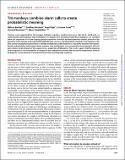Titi monkeys combine alarm calls to create probabilistic meaning
Abstract
Previous work suggested that titi monkeys Callicebus nigrifrons combine two alarm calls, the A- and B-calls, to communicate about predator type and location. To explore how listeners process these sequences, we recorded alarm call sequences of six free-ranging groups exposed to terrestrial and aerial predator models, placed on the ground or in the canopy, and used multimodel inference to assess the information encoded in the sequences. We then carried out playback experiments to identify the features used by listeners to react to the available information. Results indicated that information about predator type and location were encoded by the proportion of B-call pairs relative to all call pairs of the sequence (i.e., proportion of BB-grams). The results suggest that the meaning of the sequence is not conveyed in a categorical but probabilistic manner. We discuss the implications of these findings for current theories of animal communication and language evolution.
Citation
Berthet , M , Mesbahi , G , Pajot , A , Cäsar , C , Neumann , C & Zuberbuhler , K 2019 , ' Titi monkeys combine alarm calls to create probabilistic meaning ' , Science Advances , vol. 5 , no. 5 , eaav3991 . https://doi.org/10.1126/sciadv.aav3991
Publication
Science Advances
Status
Peer reviewed
ISSN
2375-2548Type
Journal article
Description
Funding: Our research was funded by the European Research Council under the European Union’s Seventh Framework Programme (FP7/2007–2013)/ERC grant agreement no. 283871. We acknowledge further funding from the European Union’s Seventh Framework Programme (FP/2007-2013)/ERC Grant Agreement No. 324115–FRONTSEM (PI: Schlenker) and the Institut d’Etudes Cognitives, Ecole Normale Supérieure, PSL Research University (grants ANR-10-LABX-0087 IEC and ANR-10-IDEX-0001-02 PSL), from the Swiss National Science Foundation, and from the University of Neuchâtel. The research leading to the data from 2008 to 2010 received funding from the CAPES-Brazil, FAPEMIG-Brazil, S.B. Leakey Trust, and the University of St Andrews.Collections
Items in the St Andrews Research Repository are protected by copyright, with all rights reserved, unless otherwise indicated.

